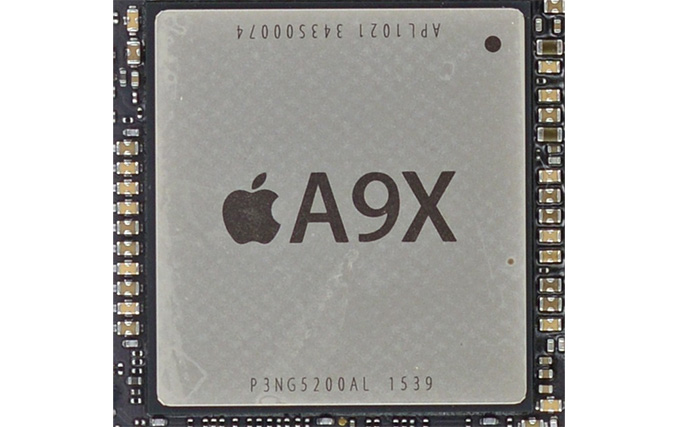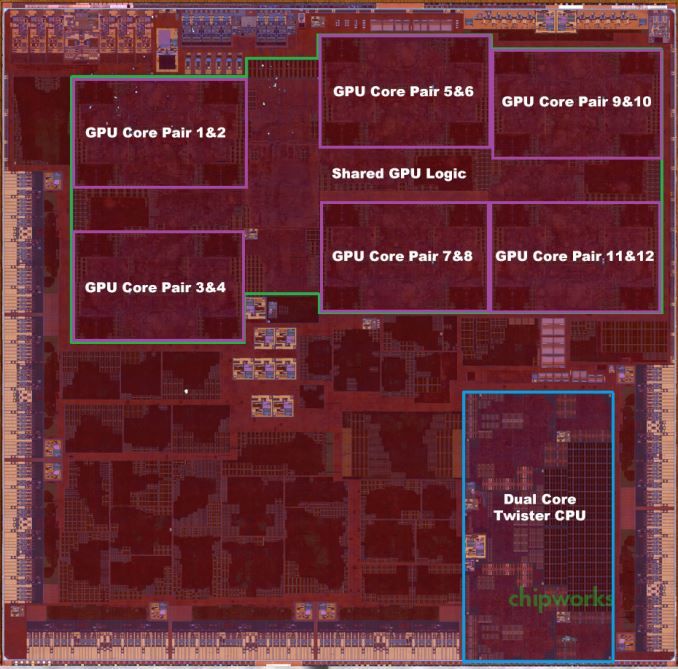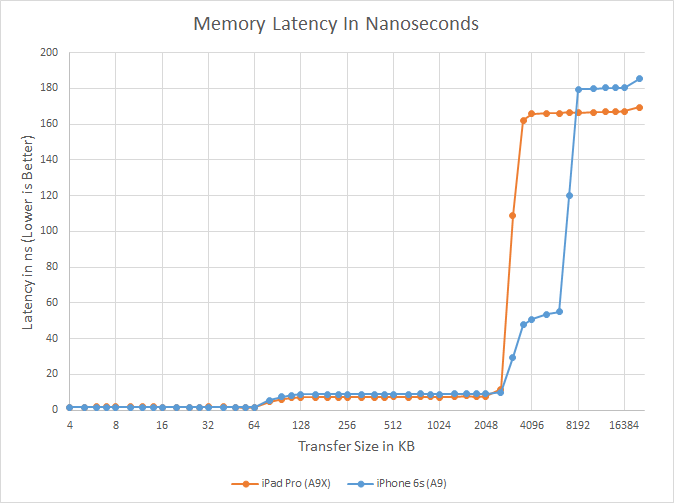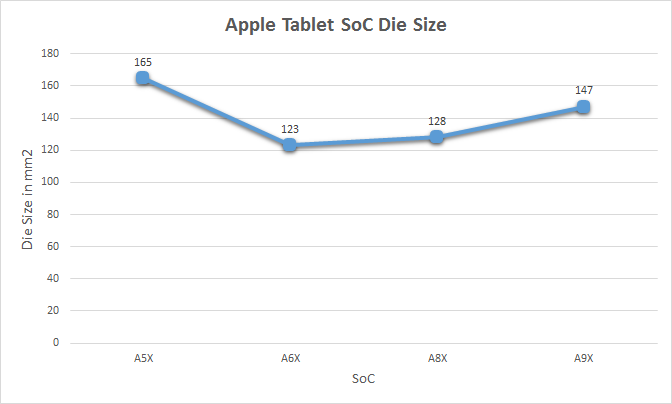The Apple iPad Pro Review
by Ryan Smith, Joshua Ho & Brandon Chester on January 22, 2016 8:10 AM ESTSoC Analysis: Apple A9X
Diving into the heart of the iPad Pro, we have Apple’s latest generation tablet SoC, A9X. Like the other Apple X series SoCs before it, A9X is by and large an enhanced and physically larger version of Apple’s latest phone SoC, taking advantage of the greater space and heat dissipation afforded by a tablet to produce a more powerful SoC.

Apple's A9X (Image Courtesy iFixit)
That Apple has developed a new SoC to launch alongside the iPad Pro is in no way surprising, but just as how the iPad Pro has ramifications for the overall iPad lineup as Apple gets into the productivity tablet market, iPad Pro’s genesis is reflected in its component selection. Apple already needed a powerful SoC for the iPad Air 2 in order to keep performance up with the tablet’s high resolution of the screen, and iPad Pro in turn pushes Apple’s performance needs even harder. Not only is there an even higher resolution screen to drive – the 2732x2048 display has about 66% of the pixels of a 4K display – but now Apple needs to deliver suitable performance for content creation and meaningful multitasking. I don’t want to imply that the A9X was somehow specifically designed from scratch for the iPad Pro, as there are a number of more important engineering considerations, but I do want to highlight how the iPad Pro is not just another iPad, and that as Apple expands the capabilities of the iPad they need to expand the performance as well if they wish to extend their reputation for smooth UX performance.
Looking at the specifications of the A9X, it seems like Apple always throws us a curveball on the X series SoCs, and for their latest SoC this is no different. With A8X Apple delivered more RAM on a wider memory bus, a larger GPU, and surprisingly, three Typhoon CPU cores. To date it’s still not clear just why Apple went with three CPU cores on A8X – was it for multitasking, or as an alternative means to boost performance – and A9X’s configuration only serves to highlight this enigma.
| Apple SoC Comparison | ||||||
| A9X | A9 | A8X | A6X | |||
| CPU | 2x Twister | 2x Twister | 3x Typhoon | 2x Swift | ||
| CPU Clockspeed | 2.26GHz | 1.85GHz | 1.5GHz | 1.3GHz | ||
| GPU | PVR 12 Cluster Series7XT | PVR 6 Cluster Series7 (PVR GT7600) |
PVR 8 Cluster Series6XT (APL GXA6850) |
PVR SGX554 MP4 | ||
| RAM | 4GB LPDDR4 | 2GB LPDDR4 | 2GB LPDDR3 | 1GB LPDDR2 | ||
| Memory Bus Width | 128-bit | 64-bit | 128-bit | 128-bit | ||
| Memory Bandwidth | 51.2GB/sec | 25.6GB/sec | 25.6GB/sec | 17.1GB/sec | ||
| L2 Cache | 3MB | 3MB | 2MB | 1MB | ||
| L3 Cache | None | 4MB | 4MB | N/A | ||
| Manufacturing Process | TSMC 16nm FinFET | TSMC 16nm & Samsung 14nm |
TSMC 20nm | Samsung 32nm | ||
Instead of continuing with a triple-core CPU design for A9X, for their latest X series SoC Apple has dropped back down to just a pair of Twister CPU cores. The catch here – and why two cores is in many ways better than three – is that relative to A8X and A9, Apple has cranked up their CPU clockspeeds. Way, way up. Whereas the iPad Air 2 (A8X) shipped at 1.5GHz and the iPhone 6s (A9) at 1.85GHz, the A9X sees Apple push their clockspeed to 2.26GHz. Not counting the architectural changes, this is 22% higher clocked than the A9 and 51% higher than the A8X.
The fact that Apple dropped back down to 2 CPU cores is unexpected given that we don’t expect Apple to ever go backwards in such a fashion, and while we’ll never know the official reason for everything Apple does, in retrospect I’m starting to think that A8X was an anomaly and Apple didn’t really want a tri-core CPU in the first place. A8X came at a time where Apple was bound by TSMC’s 20nm process and couldn’t drive up their clockspeeds without vastly increasing power consumption, so a third core was a far more power effective option.

A9X Die Shot w/AT Annotations (Die Shot Courtesy Chipworks)
Overall this means that iPad Pro and A9X will set a very high bar for tablet CPU performance. As we’ve already seen in the iPhone 6s review, the Twister CPU core is very potent and in most cases faster than any other ARM CPU core by leaps and bounds. Cranking up the clockspeed a further 22% only serves to open up that gap even further, as Twister is now reaching clockspeeds similar to the likes of Cortex-A57 and A72, but with its much wider execution pipeline and greater IPC. This is also the reason that an Intel Core CPU comparison is so interesting, as Intel’s tablet-class Core processors in many ways are the target to beat on overall CPU performance, and we’ll be touching upon this subject in greater detail a bit later.
GPU: Imagination PowerVR 12 Cluster Series 7XT
Meanwhile on the GPU side, as expected Apple has further increased the number of clusters on their SoC to drive the higher resolution display of a tablet. Whereas A9 used a 6 cluster design (PVR GT7600), A9X doubles this, giving us a relatively massive 12 cluster design.
In Imagination’s PowerVR Series7XT roadmap, the company doesn’t have an official name for a 12 cluster configuration, as this falls between the 8 cluster GT7800 and 16 cluster GT7900. So for the moment I’m simply calling it a “PowerVR 12 cluster Series7XT design,” and with any luck Imagination will use a more fine-grained naming scheme for future generations of PowerVR graphics.
In any case, the use of a 12 cluster design is a bit surprising from an engineering standpoint since it means that Apple was willing to take the die space hit to implement additional GPU clusters, despite the impact this would have on chip yields and costs. If anything, with the larger thermal capacity and battery of the iPad Pro, I had expected Apple to use higher GPU clockspeeds (and eat the power cost) in order to save on chip costs. Instead what we’re seeing is a GPU that essentially offers twice the GPU power of A9’s GPU.
However to put all of this in context, keep in mind that iPad Pro’s display is 5.95Mpixels, versus the 2.07Mpixel screen on the iPhone 6s Plus. So although Apple has doubled the number of GPU clusters for A9X – and I suspect clocked it fairly similarly – that increased performance will be very quickly consumed by the iPad Pro’s high resolution screen. Consequently even a 12 cluster GPU design is something of a compromise; if Apple wanted to maintain the same level of GPU performance per pixel as in the iPhone 6s family, they would have needed an even more powerful GPU. Which just goes to show how demanding tablets can be.
Memory Subsystem: 128-bit LPDDR4-3200, No L3 Cache
Responsibility for feeding the beast that is A9X’s GPU falls to A9X’s 128-bit LPDDR4 memory controller configuration. With twice as many GPU clusters, Apple needs twice as much memory bandwidth to maintain the same bandwidth-to-core ratio, so like the past X-series tablet SoCs, A9X implements a 128-bit bus. For Apple this means they now have a sizable 51.2GB/sec of memory bandwidth to play with. For an SoC this is a huge amount of bandwidth, but at the same time it’s quickly going to be consumed by those 12 GPU clusters.
| Geekbench 3 Memory Bandwidth Comparison (1 thread) | ||||||
| Stream Copy | Stream Scale | Stream Add | Stream Triad | |||
| Apple A9X 2.26GHz | 20.8 GB/s | 15.0 GB/s | 15.3 GB/s | 15.1 GB/s | ||
| Apple A8X 1.5GHz | 14.2 GB/s | 7.44 GB/s | 7.54 GB/s | 7.49 GB/s | ||
| A9X Advantage | 46.4% | 101% | 103% | 102% | ||
It’s also while looking at A9X’s memory subsystem however that we find our second and final curveball for A9X: the L3 cache. Or rather, the lack thereof. For multiple generations now Apple has used an L3 cache on both their phone and tablet SoCs to help feed both the CPU and GPU, as even a fast memory bus can’t keep up with a low latency local cache. Even as recent as A9, Apple included a 4MB victim cache. However for A9X there is no L3 cache; the only caches on the chip are the individual L1 and L2 caches for the CPU and GPU, along with some even smaller amounts for cache for various other functional blocks..
The big question right now is why Apple would do this. Our traditional wisdom here is that the L3 cache was put in place to service both the CPU and GPU, but especially the GPU. Graphics rendering is a memory bandwidth-intensive operation, and as Apple has consistently been well ahead of many of the other ARM SoC designers in GPU performance, they have been running headlong into the performance limitations imposed by narrow mobile memory interfaces. An L3 cache, in turn, would alleviate some of that memory pressure and keep both CPU and GPU performance up.
One explanation may be that Apple deemed the L3 cache no longer necessary with the A9X’s 128-bit LPDDR4 memory bus; that 51.2GB/sec of bandwidth meant that they no longer needed the cache to avoid GPU stalls. However while the use of LPDDR4 may be a factor, Apple’s ratio of bandwidth-to-GPU cores of roughly 4.26GB/sec-to-1 core is identical to A9’s, which does have an L3 cache. With A9X being a larger A9 in so many ways, this alone isn’t the whole story.
What’s especially curious is that the L3 cache on the A9 wasn’t costing Apple much in the way of space. Chipworks puts the size of A9’s 4MB L3 cache block at a puny ~4.5 mm2, which is just 3% the size of A9X. So although there is a cost to adding L3 cache, unless there are issues we can’t see even with a die shot (e.g. routing), Apple didn’t save much by getting rid of the L3 cache.
Our own Andrei Frumusanu suspects that it may be a power matter, and that Apple was using the L3 cache to save on power-expensive memory operations on the A9. With A9X however, it’s a tablet SoC that doesn’t face the same power restrictions, and as a result doesn’t need a power-saving cache. This would be coupled with the fact that with double the GPU cores, there would be a lot more pressure on just a 4MB cache versus the pressure created by A9, which in turn may drive the need for a larger cache and ultimately an even larger die size.
As it stands there’s no one obvious reason, and it’s likely that all 3 factors – die size, LPDDR4, and power needs – all played a part here, with only those within the halls of One Infinite Loop knowing for sure. However I will add that since Apple has removed the L3 cache, the GPU L2 cache must be sizable. Imagination’s tile based deferred rendering technology needs an on-chip cache to hold tiles in to work on, and while they don’t need an entire frame’s worth of cache (which on iPad Pro would be over 21MB), they do need enough cache to hold a single tile. It’s much harder to estimate GPU L2 cache size from a die shot (especially with Apple’s asymmetrical design), but I wouldn’t be surprised of A9X’s GPU L2 cache is greater than A9’s or A8X’s.
Building A9X Big: 147mm2, Manufactured By TSMC
Finally, let’s talk about the construction and fabrication of the A9X SoC itself. Chipworks’ previous analysis shows that the A9X is roughly 147mm2 in die size, and that it’s manufactured by TSMC on their 16nm FinFET process.
At 147mm2 the A9X is the second-largest of Apple’s X-series tablet SoCs. Only the A5X, the first such SoC, was larger. Fittingly, it was also built relative to Apple’s equally large A5 phone SoC. With only 3 previous tablet SoCs to use as a point of comparison I’m not sure there’s really a sweet spot we can say that Apple likes to stick to, but after two generations of SoCs in the 120mm2 to 130mm2 range, A9X is noticeably larger.
Some of that comes from the fact that A9 itself is a bit larger than normal – the TSMC version is 104.5mm2 – but Apple has also clearly added a fair bit to the SoC. The wildcard here is what yields look like for Apple, as that would tell us a lot about whether a 147mm2 A9X is just a large part or if Apple has taken a greater amount of risk than usual here.
A9X continues to be the largest 16nm FinFET ASIC we know to be in mass production at TSMC (we’ll ignore FPGAs for now), and while this will undoubtedly change a bit later this year once the next-generation discrete GPUs come online, I don’t think you’ll find a better example of how the contract chip manufacturing market has changed in a single generation. 4 years ago it would be GPUs leading the charge, but now it’s phone SoCs and a rather sizable tablet SoC that are first out of the gate. After almost a decade of catching up, SoCs have now reached the bleeding edge for chip fabrication, enabling rapid performance growth, but also inheriting the risks of being the leader. I won’t dwell on this too much, but I’m immensely curious about both what A9X yields are like as the largest FinFET ASIC at TSMC, and just how much of TSMC’s FinFET capacity Apple has been consuming with the production of A9 and A9X.
Finally, it's also interesting to note just how large A9X is compared to other high performance processors. Intel's latest-generation Skylake processors measure in at ~99mm2 for the 2 core GT2 configuration (Skylake-Y 2+2), and even the 4 core desktop GT2 configuration (Intel Skylake-K 4+2) is only 122mm2. So A9X is larger than either of these CPU cores, though admittedly as a whole SoC A9X contains a number of functional units either not present on Skylake or on Skylake's Platform Controller Hub (PCH). Still, this is the first time that we've seen an Apple launch a tablet SoC larger than an Intel 4 core desktop CPU.













408 Comments
View All Comments
akdj - Tuesday, January 26, 2016 - link
I'd bet Apple switches to OLED sooner than later but the combination of IGZO and A/R glare covering/coating/glass infused front end and iOS 9's (current beta. I'm not sure if it's life in the current version of public iOS) display 'blue point' setting helps significantly at night, while reading. You're able to turn the temp down, fairly low in temp to help your eyes in the dark with a warmer screen. I use it every night. Amazing, yet small addition to iOS that - again may go unnoticed but if you take advantage of it, your eyes will thank you!I'm actually using Pencil in right hand, left free to hold or help type -- as you can navigate, open apps, manipulate the iPad and UI with the pencil but with a LOT more precision whether using a sketch pad, editing in Pinnacle or iMovie, GarageBand, or even using playback apps like dJay, games, and writing or notating a PDF, picture or just prefer sending a hand written note, it's an exceptional piece of hardware and the App Store's selection of apps, the best in history and at the lowest cost we've enjoyed ...in history.
I'm floored by the accelerated pace of apps being updated for support of both iPP and the Apple Watch. Niche product? Sure, but as a smaller iPad owner as well I'd LOVE to see this speaker tech drizzle down the line. Speakers, SoC and the 'speed' of this guy are phenomenal and anyone that spends anytime with one and apps from Adobe, MS, Autodesk or other big software devs, you'll immediately 'see' what the authors are discussing and the enjoyment many have found in ownership.
As the workplace transitions to BYOD, Jr and HSchools transition to the same --- as well as colleges, iPads of all shapes and sizes can be seen. That said, the iPP offering of the Pencil takes this another step forward for education and medical/sciences/teaching, audio production, mobile video capture, controlling your Parrot or --- as many ignorant, haven't seen or touched it yet, folks will tell you -- 'consumption'. Media; music, videos, books and magazines --- all look, sound and are more enjoyable with the larger display, significantly upgraded speakers and improved perfomance make it the perfect iPad --- for me.
I still have my rMBP 15" at home for heavier lifting my iMacs and Mac Pro in studio but the use they get is minimal compared to just a couple years ago. For everyday everyone tasks; email, surfing, comms, Twit, FB, Instagram or fill in favorite social site here -- to wifi calling, continuity with the rest of your system through handoff, and sooooo many other little things that took me away from 20 years of PC usage seven years ago to strictly OS X and iOS - with Win 7/10 on partitions of the MP in the case software is proprietary to Windows --- an ever growing anomaly rather than the usual just a half decade ago
ALL the big software developers have switched up staff and dollars from desk and laptop to mobile development --- some, over 50%! Adobe's got a dozen companion apps as does Google (that run many times better on iOS than my Android devices!) -Autodesk and Microsoft both demonstrated their software at the iPP release and I've been using the MS suite since the day it dropped, subscribed to Adobe CC since its inception and have watched literally ...weekly updates to their companion iOS software. To the extent they've rewritten ALL of their apps for 64bit compatibility opimized to iOS and are absolutely phenomenal --- certainly not 'gimped' - bit extensions of the CC suite on your MBP, MP, iMac or iPhone!
Anyway, as you seem to get it, that it's a great tablet --- as far as nighttime reading, the latest iOS drop allows much more granular control of the screen temp than Android's standard, cinema, photo, and adaptive settings. Definitely help with reading in the dark!
J
SFoster4 - Friday, January 22, 2016 - link
I am an IBM mainframe systems programmer and have been for 38 years. I have been using PC's as well for longer than many of you have been alive. I have seen and owned lots of hardware. The hardware along with the software will always evolve. Why can't you people just enjoy the changes, I do. I bought an iPad Pro. I love it. I am typing on it right now. But I am not going to lambaste others for using different devices. If there was only one solution then the hardware/software would be boring. However that might not be a bad thing because then I would have to read all of childish rants of my d*** is bigger than your d***.blackcrayon - Saturday, January 23, 2016 - link
Thank you.Unfortunately, there doesn't seem to be any correlation between maturity and interest in tech...
klassobanieras - Friday, January 22, 2016 - link
"When discussing azimuth, we’re basically looking at the angle that the stylus makes with the plane of the display, while altitude is the angle that the stylus makes relative to the normal of the display"This could be more clearly expressed - the azimuth is the angle of the pencil *within* the display plane vs the horizontal axis, not the angle it makes with the plane itself.
Constructor - Saturday, January 23, 2016 - link
Basically the Pencil gives:• pixel-precise location (x, y)
• pretty precise pressure (from manual testing – subtle pressure variations come through very well)
• relatively crude inclination (looks like only a few increments from 0..90° in the software I've checked)
• relatively precise direction when inclined (dx, dy – when shading "sideways" it knows the orientation of the point)
SaolDan - Friday, January 22, 2016 - link
The only way i could call this thing "pro" is if it could run the software i use for work. I-lux, ETC software, crestron software, ILC software, wattstopper software, i could keep naming software. Im that years down the road some of them could be available in ios but as a lesser crappy app. My boss is an ipad freak and he wont buy ipads for the company because we cant load any of the software we need to use. The device looks nice and its huge in a good way. Sucks that it doesnt have a usb drive and file system. No this cant not replace a laptop. No it cant run real games. It all depends on what use u give it.blackcrayon - Sunday, January 24, 2016 - link
You really don't understand why they used "pro"?Look, Samsung makes a 256GB 850 PRO ssd. For my job, 256 gigs isn't nearly enough. How can it be pro? Because it has features and performance above and beyond their other models. It's just a label. It doesn't mean every profession on the planet will find it to be the perfect device. I know a lot of graphics professionals that could use an iPad Pro in their workflow where an Air wouldn't have worked very well (pencil, larger screen).
Constructor - Sunday, January 24, 2016 - link
No, the Samsung "pro" SSDs are not just a different badge. They also use different chips with a different architecture for more consistent performance and for increased reliability.With the iPad it's more similar to the MacBook Pro: Anyone can use it for anything; It's mostly similar to the smaller models. But its full-page document capability, its professional-grade Pencil and its high processor performance make it more suitable for demanding work than any other model.
MaxIT - Saturday, February 13, 2016 - link
The whole "pro" bitching is utterly ridiculous. One can use a Mac Pro for Safari and Mail while another could earn real money just using an iPad mini ... Who's the "Pro" here ?MaxIT - Saturday, February 13, 2016 - link
World doesn't end at your job...And the iPad pro DOES have a file system.